Exhaust Emissions from a Hybrid City Bus Fuelled by Conventional and Oxygenated Fuel
Abstract
:1. Introduction
2. Materials and Methods
2.1. Test Fuels
2.2. Research Apparatus
2.3. Research Driving Cycles
- −
- crowded city traffic (SORT 1—heavy urban),
- −
- moderate urban traffic (SORT 2—easy urban),
- −
- suburban traffic (SORT 3—suburban).
2.4. Test Vehicles
3. Test Results and Discussion
3.1. Hybrid Bus Test Results
3.2. Comparison of Exhaust Emissions for Hybrid and Conventional City Buses
4. Conclusions
Author Contributions
Funding
Institutional Review Board Statement
Informed Consent Statement
Data Availability Statement
Conflicts of Interest
References
- Krzyżanowski, M.; Apte, J.S.; Bonjour, S.P.; Brauer, M.; Cohen, A.J.; Prüss-Ustun, A.M. Air Pollution in the Mega-cities. Curr. Environ. Health Rep. 2014, 1, 185–191. [Google Scholar] [CrossRef]
- Pirjola, L.; Lähde, T.; Niemi, J.V.; Kousa, A.; Rönkkö, T.; Karjalainen, P.; Keskinen, J.; Frey, A.; Hillamo, R. Spatial and temporal characterization of traffic emissions in urban microenvironments with a mobile laboratory. Atmos. Environ. 2012, 63, 156–167. [Google Scholar] [CrossRef]
- Sarzynski, A. Bigger Is Not Always Better: A Comparative Analysis of Cities and their Air Pollution Impact. Urban Stud. 2012, 49, 3121–3138. [Google Scholar] [CrossRef]
- Mills, N.L.; Tornqvist, H.; Robinson, S.D.; Gonzalez, M.; Darnley, K.; MacNee, W.; Boon, N.A.; Donaldson, K.; Blomberg, A.; Sandstrom, T.; et al. Diesel exhaust inhalation causes vascular dysfunction and impaired endogenous fibrinolysis. Circulation 2005, 112, 3930–3936. [Google Scholar] [CrossRef] [Green Version]
- Nightingale, J.A.; Maggs, R.; Cullinan, P.; Donnelly, L.E.; Rogers, D.F.; Kinnersley, R.; Chung, K.F.; Barnes, P.J.; Ashmore, M.; Newman-Taylor, A. Airway inflammation after controlled exposure to diesel exhaust particulates. Am. J. Respir. Crit. Care Med. 2000, 162, 161–166. [Google Scholar] [CrossRef]
- Scheepers, P.; Bos, R. Combustion of diesel fuel from a toxicological perspective. Int. Arch Occup. Environ. Heath 1992, 64, 149–161. [Google Scholar] [CrossRef]
- International Agency for Research on Cancer—Diesel Engine Exhaust Carcinogenic. Press Release No. 213 of 12 June 2012. Available online: https://www.iarc.who.int/wp-content/uploads/2018/07/pr213_E.pdf (accessed on 2 August 2021).
- Silverman, D.T. Diesel Exhaust and Lung Cancer—Aftermath of Becoming an IARC Group 1 Carcinogen. Am. J. Epidemiol. 2018, 187, 1149–1152. [Google Scholar] [CrossRef]
- Grigoratos, T.; Fontaras, G.; Giechaskiel, B.; Zacharof, N. Real world emissions performance of heavy-duty Euro VI diesel vehicles. Atmos. Environ. 2019, 201, 348–359. [Google Scholar] [CrossRef]
- He, L.; Hu, J.; Zhang, S.; Wu, Y.; Guo, X.; Song, J.; Zu, L.; Zheng, X.; Bao, X. Investigating Real-World Emissions of China’s Heavy-Duty Diesel Trucks: Can SCR Effectively Mitigate NOx Emissions for Highway Trucks? Aerosol Air Qual. Res. 2017, 17, 2585–2594. [Google Scholar] [CrossRef] [Green Version]
- Resitoglu, I.A.; Altinisik, K.; Keskin, A. The pollutant emissions from diesel-engine vehicles and exhaust aftertreatment systems. Clean Technol. Environ. Policy 2015, 17, 15–27. [Google Scholar] [CrossRef] [Green Version]
- Wang, M.; Zhu, R.; Zhang, R.; Li, S.; Bao, X. On-road emission characteristics of volatile organic compounds from light-duty diesel trucks meeting different emission standards—investigation on the characteristics of tailpipe volatile organic compound emissions with a portable emissions measurement system. Johns. Matthey Technol. Rev. 2021, 65, 404–417. [Google Scholar] [CrossRef]
- DELPHI Technologies. 2018-2019 Worldwide Emissions Standards—On and Off-Highway Commercial Vehicles. Available online: https://www.delphi.com/sites/default/files/2020-03/2018-2019%20Heavy-Duty%20&%20Off-Highway%20Vehicles.pdf (accessed on 27 December 2021).
- DELPHI Technologies. 2020-2021 Worldwide Emissions Standards—Passenger Cars and Light Duty Vehicles. Available online: https://www.delphi.com/sites/default/files/2020-04/DELPHI%20booklet%20emission%20passenger%20cars%202020%20online%20complet.pdf (accessed on 27 December 2021).
- Continental. Worldwide Emission Standards and Related Regulations Passenger Cars/Light and Medium Duty Vehicles. Available online: https://www.continental-automotive.com/getattachment/8f2dedad-b510-4672-a005-3156f77d1f85/EMISSIONBOOKLET_2019.pdf (accessed on 27 December 2021).
- Lijewski, P.; Kozak, M.; Fuć, P.; Rymaniak, Ł.; Ziółkowski, A. Exhaust Emissions Generated Under Actual Operating Conditions from a Hybrid Vehicle and an Electric One Fitted with a Range Extender. Transp. Res. Part D Transp. Environ. 2020, 78, 102183. [Google Scholar] [CrossRef]
- Lijewski, P.; Szymlet, N.; Rymaniak, Ł.; Sokolnicka, B.; Domowicz, A. The Impact of Operating Conditions on Exhaust Emissions from a Two-Wheeled Urban Vehicle. E3S Web Conf. 2019, 100, 00047. [Google Scholar] [CrossRef] [Green Version]
- Merkisz, J.; Kozak, M.; Nijak, D.; Andrzejewski, M.; Nowak, M.; Rymaniak, Ł.; Ziółkowski, A. The analysis of the emission level from a heavy-duty truck in city traffic. Combust. Engines 2012, 150, 80–88. [Google Scholar] [CrossRef]
- Prati, M.V.; Costagliola, M.A.; Giuzio, R.; Corsetti, C.; Beatrice, C. Emissions and energy consumption of a plug-in hybrid passenger car in Real Driving Emission (RDE) test. Transp. Eng. 2021, 4, 100069. [Google Scholar] [CrossRef]
- Rymaniak, Ł.; Ziółkowski, A.; Gallas, D. Particle Number and Particulate Mass Emissions of Heavy Duty Vehicles in Real Operating Conditions. MATEC Web Conf. 2017, 118, 00025. [Google Scholar] [CrossRef]
- Szymlet, N.; Lijewski, P.; Sokolnicka, B.; Siedlecki, M.; Domowicz, A. Analysis of Research Method, Results and Regulations Regarding the Exhaust Emissions from Two-Wheeled Vehicles under Actual Operating Conditions. J. Ecol. Eng. 2020, 21, 128–139. [Google Scholar] [CrossRef]
- Liu, Q.; Hallquist, A.M.; Fallgren, H.; Jerksjö, M.; Jutterström, S.; Salberg, H.; Hallquist, M.; Le Breton, M.; Pei, X.; Pathak, R.K.; et al. Roadside assessment of a modern city bus fleet: Gaseous and particle emissions. Atmos. Environ. X 2019, 3, 100044. [Google Scholar] [CrossRef]
- Keramydas, C.; Papadopoulos, G.; Ntziachristos, L.; Lo, T.-S.; Ng, K.-L.; Wong, H.-L.A.; Wong, C.K.-L. Real-World Measurement of Hybrid Buses’ Fuel Consumption and Pollutant Emissions in a Metropolitan Urban Road Network. Energies 2018, 11, 2569. [Google Scholar] [CrossRef] [Green Version]
- Dreier, D.; Silveira, S.; Khatiwada, D.; Fonseca, K.; Nieweglowski, R.; Schepanski, R. Well-to-Wheel analysis of fossil energy use and greenhouse gas emissions for conventional, hybrid-electric and plug-in hybrid-electric city buses in the BRT system in Curitiba, Brazil. Transp. Res. Part D Transp. Environ. 2018, 58, 122–138. [Google Scholar] [CrossRef]
- Mumali, F.; Kałkowska, J. Intelligent System Support Potential in Manufacturing Process Management. In Proceedings of the 36th International Business Information Management Association Conference (IBIMA)—Sustainable Economic Development and Advancing Education Excellence in the era of Global Pandemic, Granada, Spain, 4–5 November 2020. [Google Scholar]
- ITF Transport Outlook 2021; OECD Publishing: Paris, France, 2021; Available online: https://doi.org/10.1787/16826a30-en (accessed on 2 August 2021).
- CIVITAS—Policy Note—Clean Buses for Your City. Available online: http://civitas.eu/sites/default/files/civitas_policy_note_clean_buses_for_your_city.pdf (accessed on 2 August 2021).
- Gis, W.; Gis, M.; Pielecha, J. Comparative Studies of Exhaust Emissions from Three City Buses in Real Traffic Conditions, One with LNG, the Other with CI Engine and a Hybrid Bus; SAE Technical Paper 2020-01-2191; SAE: Warrendale, PA, USA, 2020. [Google Scholar] [CrossRef]
- Gómez, A.; Fernández-Yáñez, P.; Soriano, J.A.; Sánchez-Rodríguez, L.; Mata, C.; García-Contreras, R.; Armas, O.; Cárdenas, M.D. Comparison of real driving emissions from Euro VI buses with diesel and compressed natural gas fuels. Fuel 2021, 289, 119836. [Google Scholar] [CrossRef]
- Kurczyński, D.; Wcisło, G.; Łagowski, P. Experimental Study of Fuel Consumption and Exhaust Gas Composition of a Diesel Engine Powered by Biodiesel from Waste of Animal Origin. Energies 2021, 14, 3472. [Google Scholar] [CrossRef]
- Merkisz, J.; Fuć, P.; Lijewski, P.; Pielecha, J. Actual Emissions from Urban Buses Powered with Diesel and Gas Engines. Transp. Res. Procedia 2016, 14, 3070–3078. [Google Scholar] [CrossRef] [Green Version]
- Nanaki, E.A.; Koroneos, C.J.; Xydis, G.A.; Rovas, D. Comparative environmental assessment of Athens urban buses—Diesel, CNG and biofuel powered. Transp. Policy 2014, 35, 311–318. [Google Scholar] [CrossRef]
- Rimkus, A.; Melaika, M.; Matijosius, J. Efficient and Ecological Indicators of CI Engine Fuelled with Different Diesel and LPG Mixtures. Procedia Eng. 2017, 187, 504–512. [Google Scholar] [CrossRef]
- Boot, M.D.; Frijters, J.M.; Klein-Douwel, R.J.H.; Baert, R.S.G. Oxygenated Fuel Composition Impact on Heavy-Duty Diesel Engine Emissions; SAE Technical Paper 2007-01-2018; SAE: Warrendale, PA, USA, 2007. [Google Scholar] [CrossRef]
- Delfort, B.; Durand, I.; Jaecker-Voirol, A.; Lacome, T.; Paille, F.; Montagne, X. Oxygenated Compounds and Diesel Engine Pollutant Emissions Performances of New Generation of Products; SAE Technical Paper 2002-01-2852; SAE: Warrendale, PA, USA, 2002. [Google Scholar] [CrossRef]
- Hallgren, B.E.; Heywood, J.B. Effects of Oxygenated Fuels on DI Diesel Combustion and Emissions; SAE Technical Paper 2001-01-0648; SAE: Warrendale, PA, USA, 2001. [Google Scholar] [CrossRef] [Green Version]
- Kocis, D.; Song, H.; Lee, H.; Litzinger, T. Effects of Dimethoxymethane and Dimethylcarbonate on Soot Production in an Optically-accessible DI Diesel Engine; SAE Technical Paper 2000-01-2795; SAE: Warrendale, PA, USA, 2000. [Google Scholar] [CrossRef]
- Stoner, M.; Litzinger, T. Effects of Structure and Boiling Point of Oxygenated Blending Compounds in Reducing Diesel Emissions; SAE Paper 1999-01-1475; SAE: Warrendale, PA, USA, 1999. [Google Scholar] [CrossRef]
- Yeh, L.I.; Rickeard, D.J.; Duff, J.L.C.; Bateman, J.R.; Schlosberg, R.H.; Caers, R.F. Oxygenates: An Evaluation of Their Effects on Diesel Emissions; SAE Technical Paper 2001-01-2019; SAE: Warrendale, PA, USA, 2001. [Google Scholar] [CrossRef]
- Kozak, M.; Merkisz, J.; Bielaczyc, P.; Szczotka, A. The Influence of Synthetic Oxygenates on Euro IV Diesel Passenger Car Exhaust Emissions; SAE Technical Paper 2007-01-0069; SAE: Warrendale, PA, USA, 2007. [Google Scholar] [CrossRef]
- Kozak, M.; Merkisz, J.; Bielaczyc, P.; Szczotka, A. The Influence of Synthetic Oxygenates on Euro IV Diesel Passenger Car Exhaust Emissions—Part 2; SAE Technical Paper 2008-01-1813; SAE: Warrendale, PA, USA, 2008. [Google Scholar] [CrossRef]
- Kozak, M.; Merkisz, J.; Bielaczyc, P.; Szczotka, A. The Influence of Synthetic Oxygenates on Euro IV Diesel Passenger Car Exhaust Emissions—Part 3; SAE Technical Paper 2008-01-2387; SAE: Warrendale, PA, USA, 2008. [Google Scholar] [CrossRef]
- Kozak, M.; Merkisz, J.; Bielaczyc, P.; Szczotka, A. The Influence of Oxygenated Diesel Fuels on a Diesel Vehicle PM/NOx Emission Trade-Off; SAE Technical Paper 2009-01-2696; SAE: Warrendale, PA, USA, 2009. [Google Scholar] [CrossRef]
- Kozak, M. Study on the Influence of Diesel Fuel’s Oxygenated Compounds on Exhaust Emissions from Diesel Engines; Publishing House of Poznań University of Technology: Poznań, Poland, 2013. (In Polish) [Google Scholar]
- Porai, P.; Chandrasekaran, S.; Subramaniyam, S.; Jancirani, J.; Sahoo, B. Combustion and Performance of a Diesel Engine with Oxygenated Diesel Blend; SAE Technical Paper 2004-01-0082; SAE: Warrendale, PA, USA, 2001. [Google Scholar] [CrossRef]
- Dumitrescu, C.E.; Mueller, C.J.; Kurtz, E. Investigation of a tripropylene-glycol monomethyl ether and diesel blend for soot-free combustion in an optical direct-injection diesel engine. Appl. Therm. Eng. 2016, 101, 639–646. [Google Scholar] [CrossRef] [Green Version]
- Serhan, N.; Tsolakis, A.; Martos, F.J. Effect of propylene glycol ether fuelling on the different physico-chemical properties of the emitted particulate matters: Implications of the soot reactivity. Fuel 2018, 219, 1–11. [Google Scholar] [CrossRef] [Green Version]
- Pellegrini, L.; Marchionna, M.; Patrini, R.; Florio, S. Emission Performance of Neat and Blended Polyoxymethylene Dimethyl Ethers in an Old Light-Duty Diesel Car; SAE Technical Paper 2013-01-1035; SAE: Warrendale, PA, USA, 2013. [Google Scholar] [CrossRef]
- Dworschak, P.; Berger, V.; Härtl, M.; Wachtmeister, G. Particle Size Distribution Measurements of Neat and Water-Emulsified Oxymethylene Ethers in a Heavy-Duty Diesel Engine. SAE Int. J. Fuels Lubr. 2020, 13, 187–203. [Google Scholar] [CrossRef]
- Hana, J.; Wanga, S.; Vittorib, R.M.; Somersa, L.M.T. Experimental study of the combustion and emission characteristics of oxygenated fuels on a heavy-duty diesel engine. Fuel 2020, 268, 117219. [Google Scholar] [CrossRef]
- Härtl, M.; Seidenspinner, P.; Jacob, E.; Wachtmeister, G. Oxygenate screening on a heavy-duty diesel engine and emission characteristics of highly oxygenated oxymethylene ether fuel OME1. Fuel 2015, 153, 328–335. [Google Scholar] [CrossRef]
- Wei, J.; Zeng, Y.; Pan, M.; Zhuang, Y.; Qiu, L.; Zhou, T.; Liu, Y. Morphology analysis of soot particles from a modern diesel engine fueled with different types of oxygenated fuels. Fuel 2020, 267, 117248. [Google Scholar] [CrossRef]
- Corriere, F.; Guerrieri, M.; Ticali, D.; Messineo, A. Estimation of Air Pollutant Emissions in Flower Roundabouts and in Conventional Roundabouts. Arch. Civ. Eng. 2013, 59, 229–246. [Google Scholar] [CrossRef]
- Guerrieri, M.; Corriere, F.; Parla, G.; Vincenzo, D.D.; Messineo, A. Reducing Air Pollutants through Road Innovative Intersections. Appl. Mech. Mater. 2013, 459, 563–568. [Google Scholar] [CrossRef]
- Shancita, I.; Masjuki, H.H.; Kalam, M.A.; Fattah, I.M.R.; Rashed, M.M.; Rashedul, H.K. A review on idling reduction strategies to improve fuel economy and reduce exhaust emissions of transport vehicles. Energy Convers. Manag. 2014, 88, 794–807. [Google Scholar] [CrossRef]
- Nabi, M.; Hustad, J. Effect of Fuel Oxygen on Engine Performance and Exhaust Emissions Including Ultrafine Particle Fueling with Diesel-Oxygenate Blends; SAE Technical Paper 2010-01-2130; SAE: Warrendale, PA, USA, 2010. [Google Scholar] [CrossRef]
- Srinivasan, P.; Devaradjane, G. Experimental Investigations on Performance and Emission Characteristics of Diesel Fuel Blended with 2-Ethoxy Ethyl Acetate and 2-Butoxy Ethanol; SAE Technical Paper 2008-01-1681; SAE: Warrendale, PA, USA, 2008. [Google Scholar] [CrossRef]

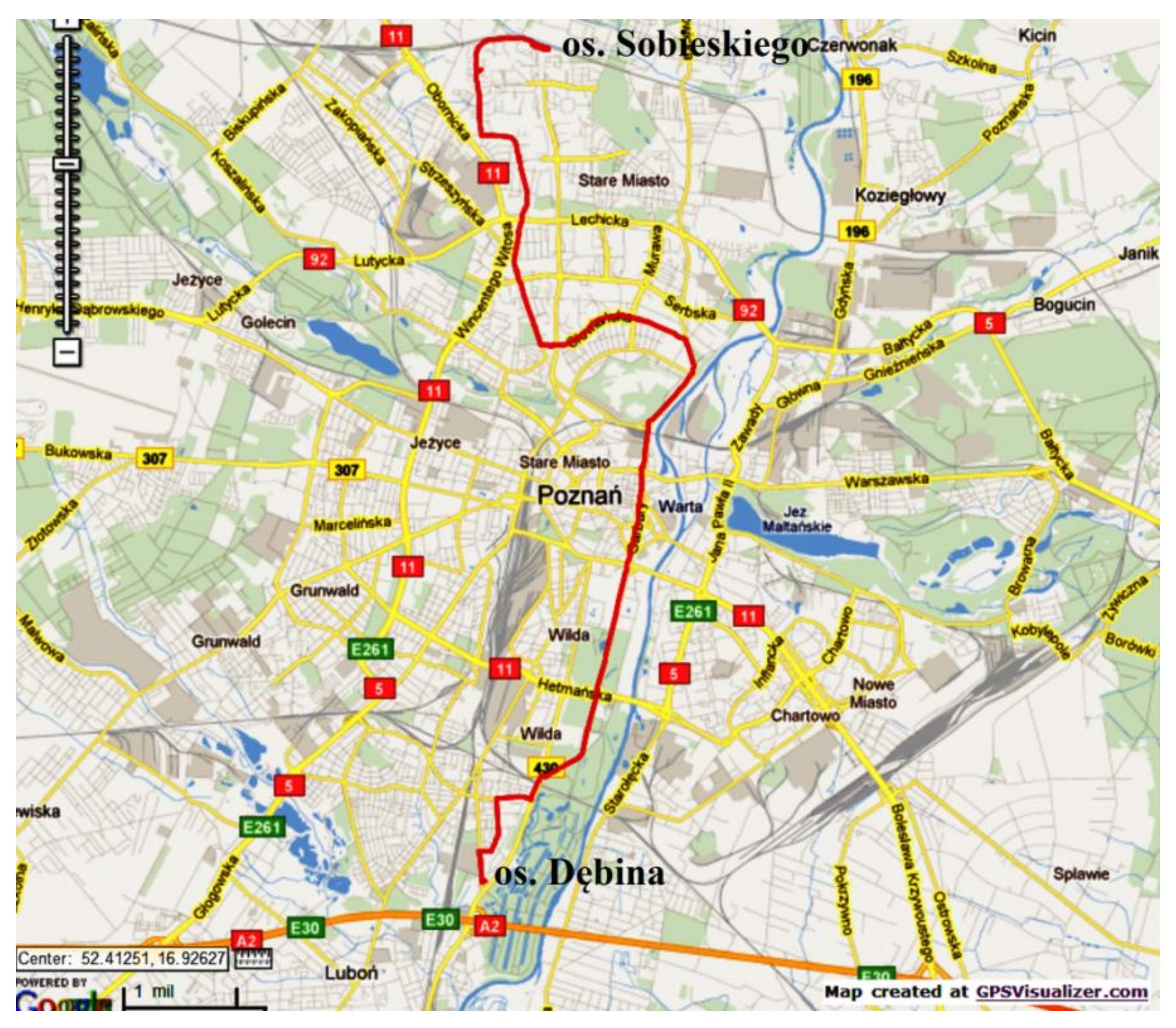
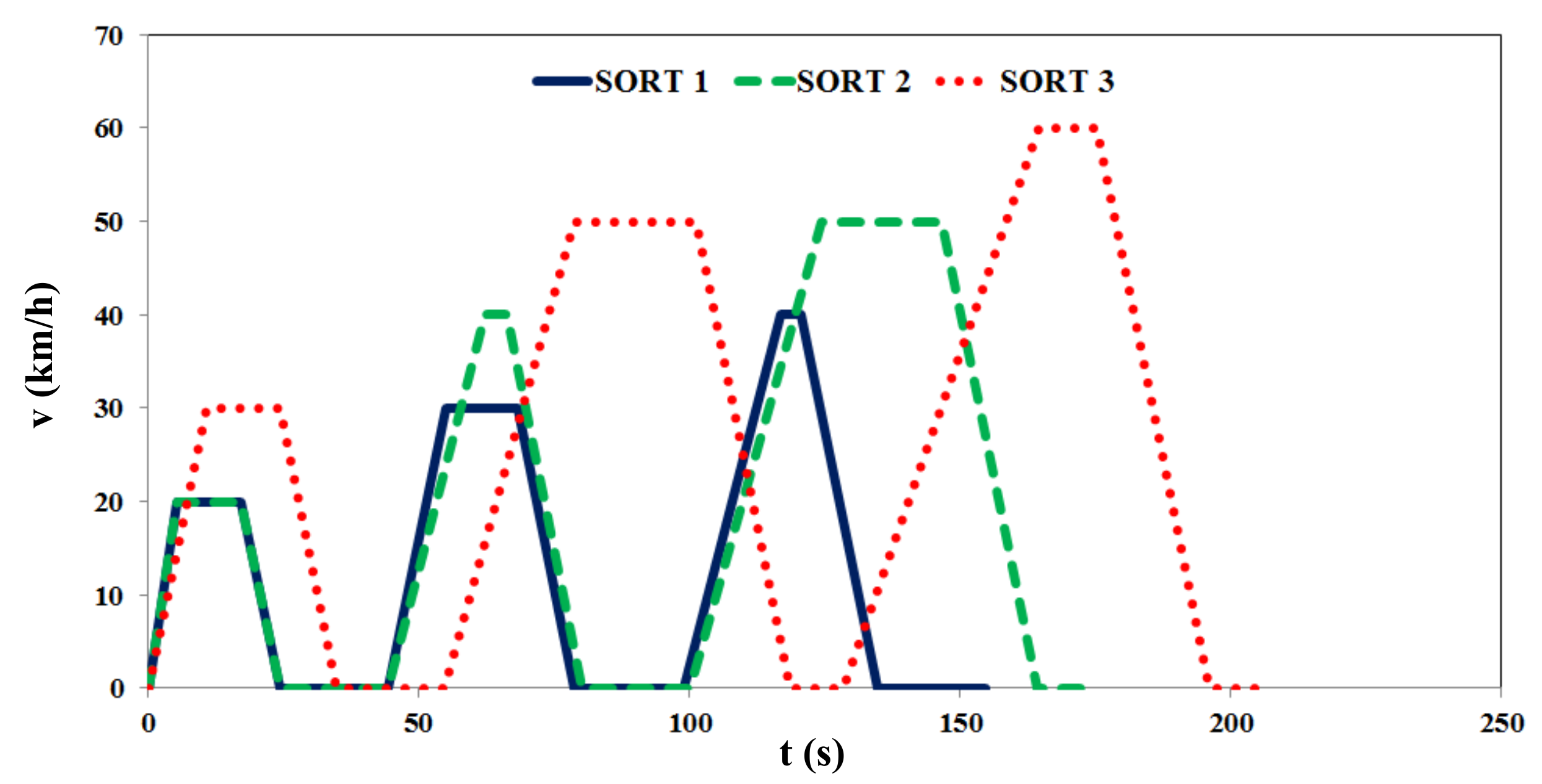

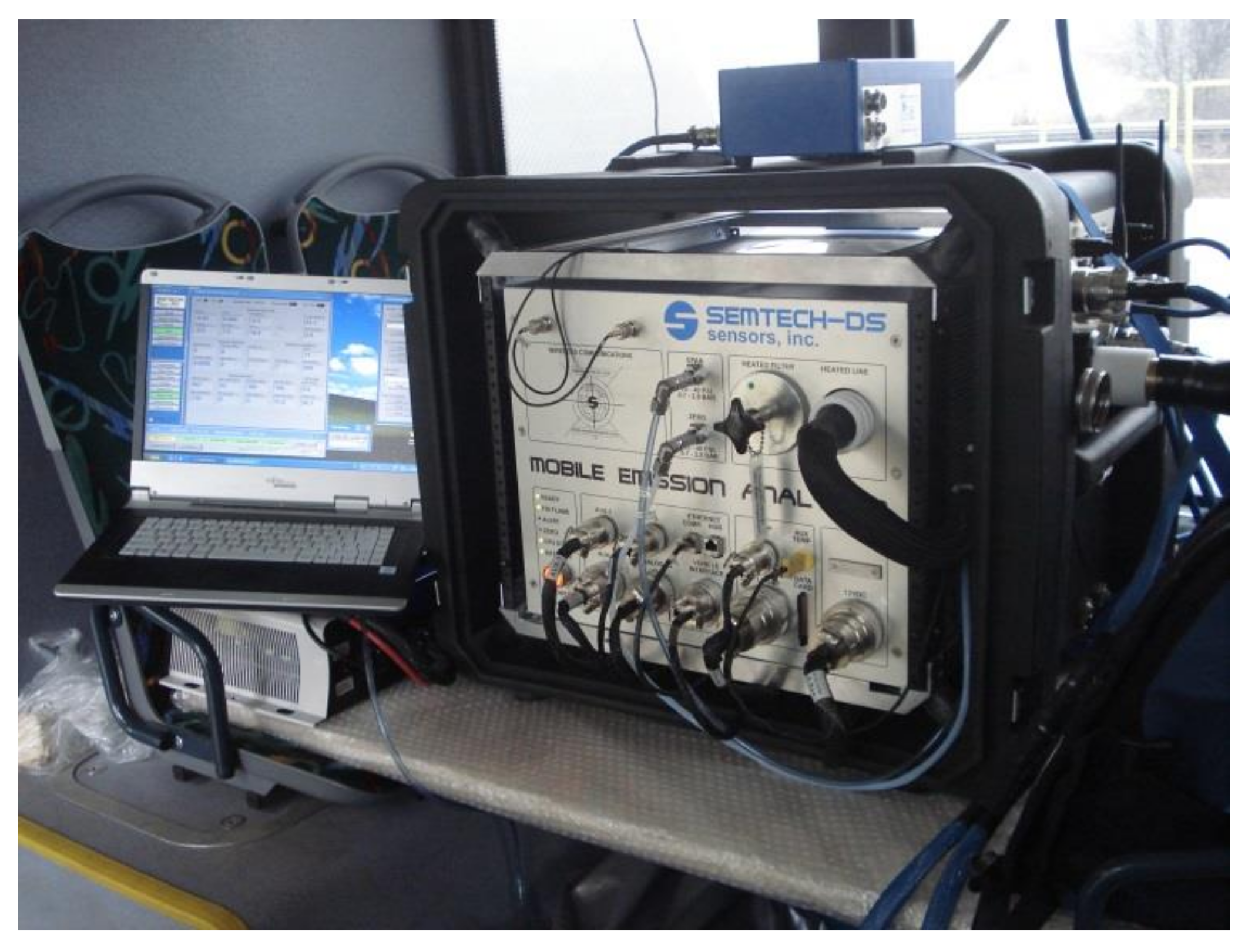
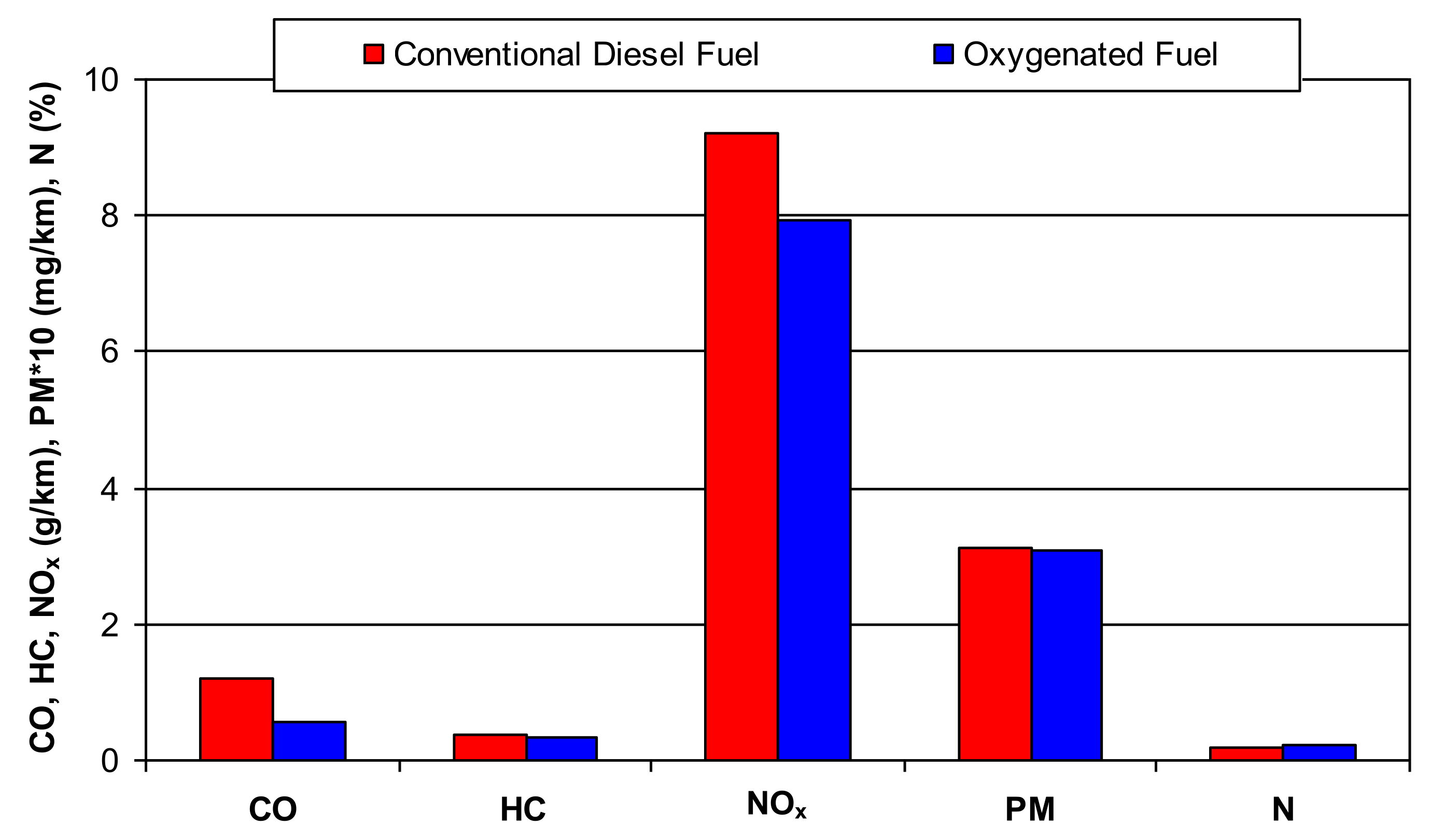
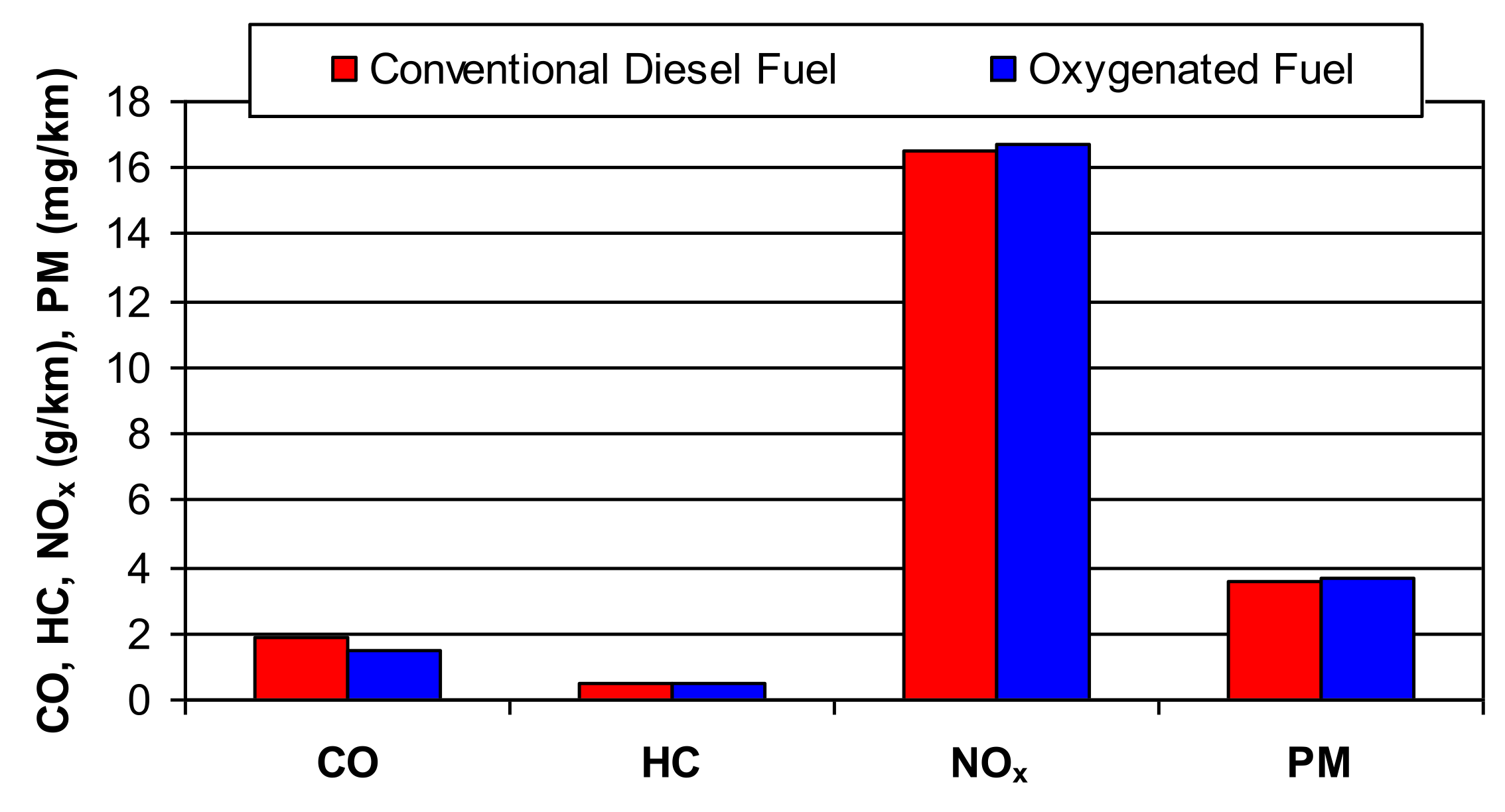
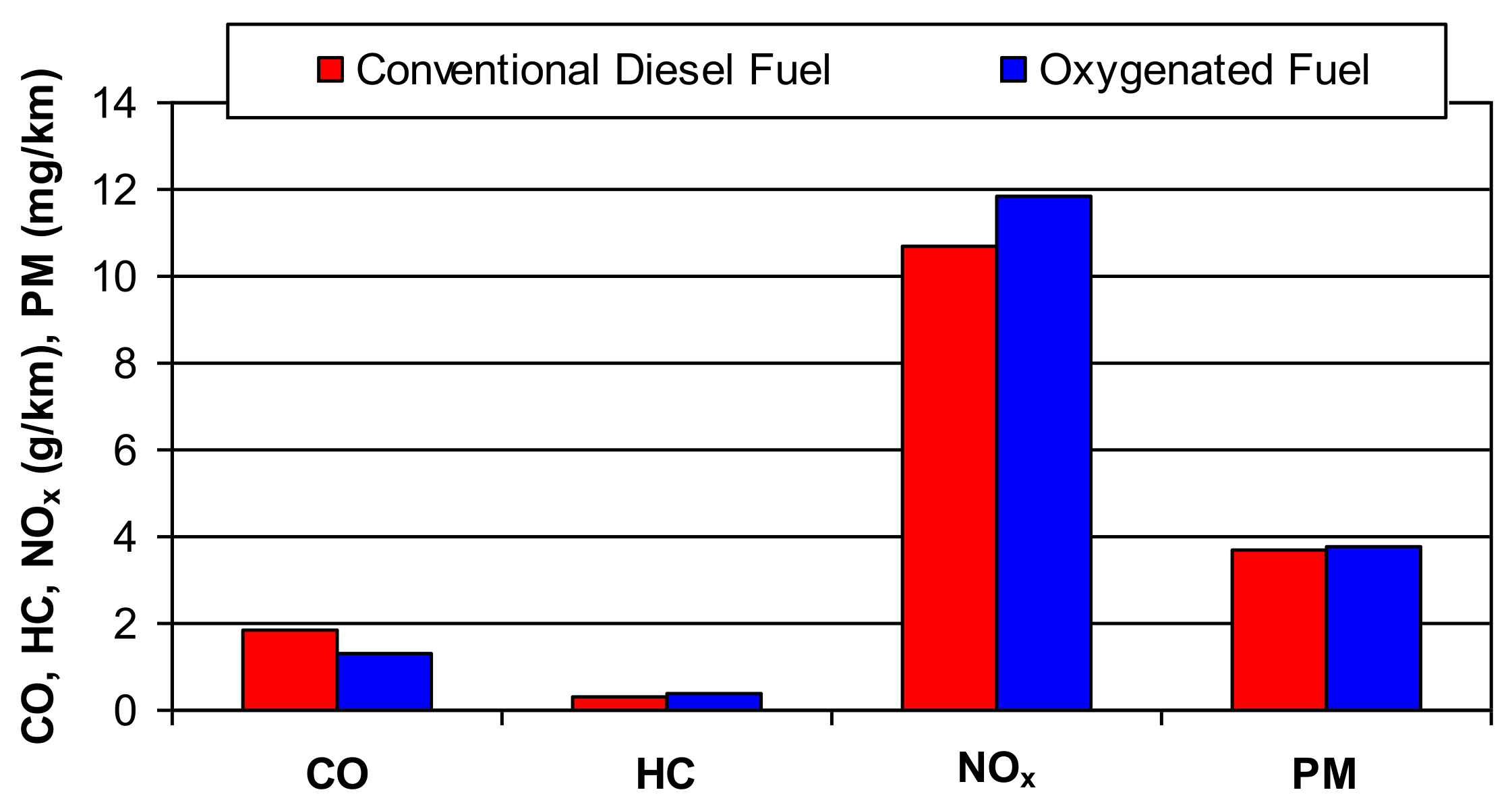
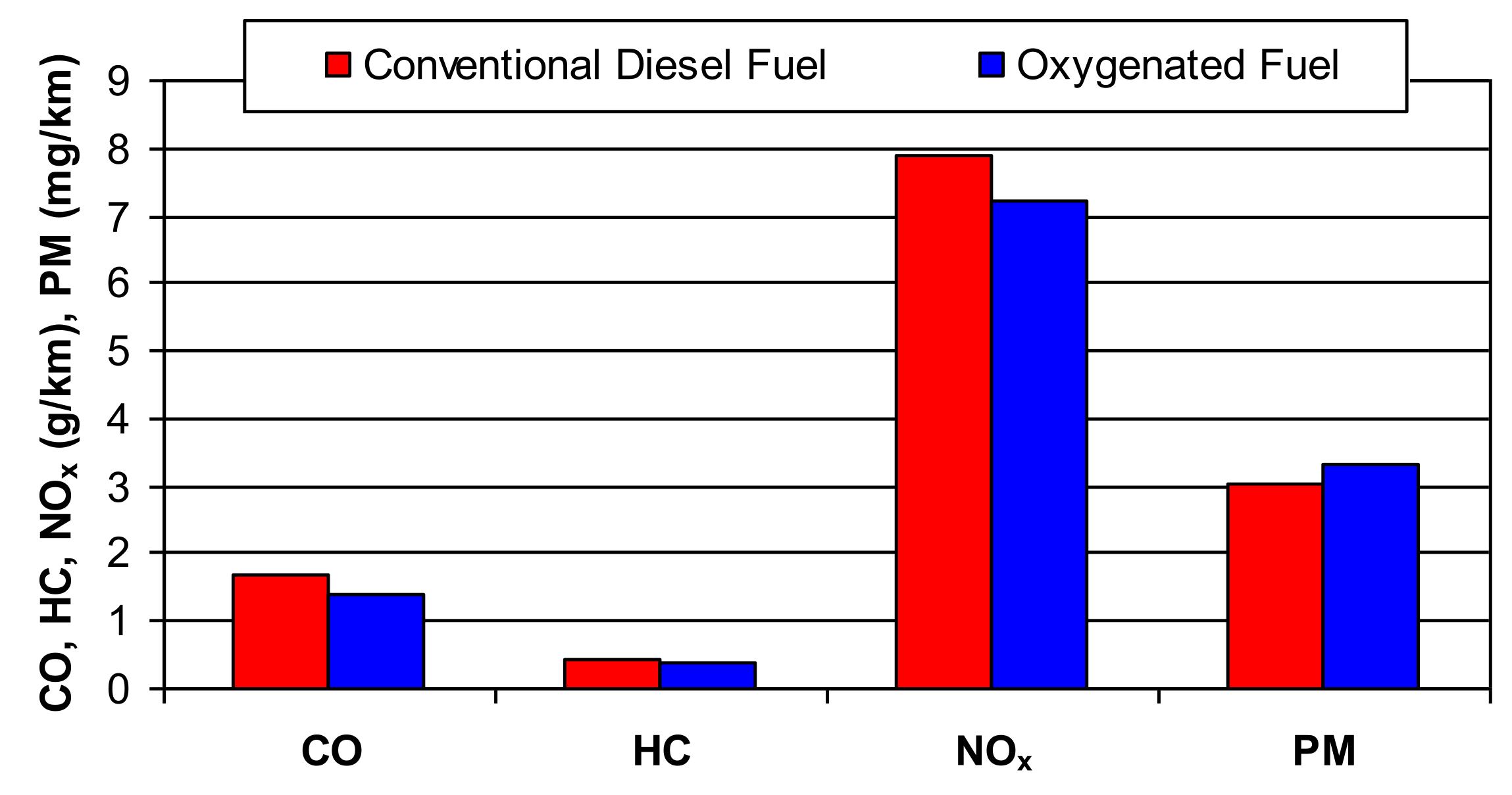
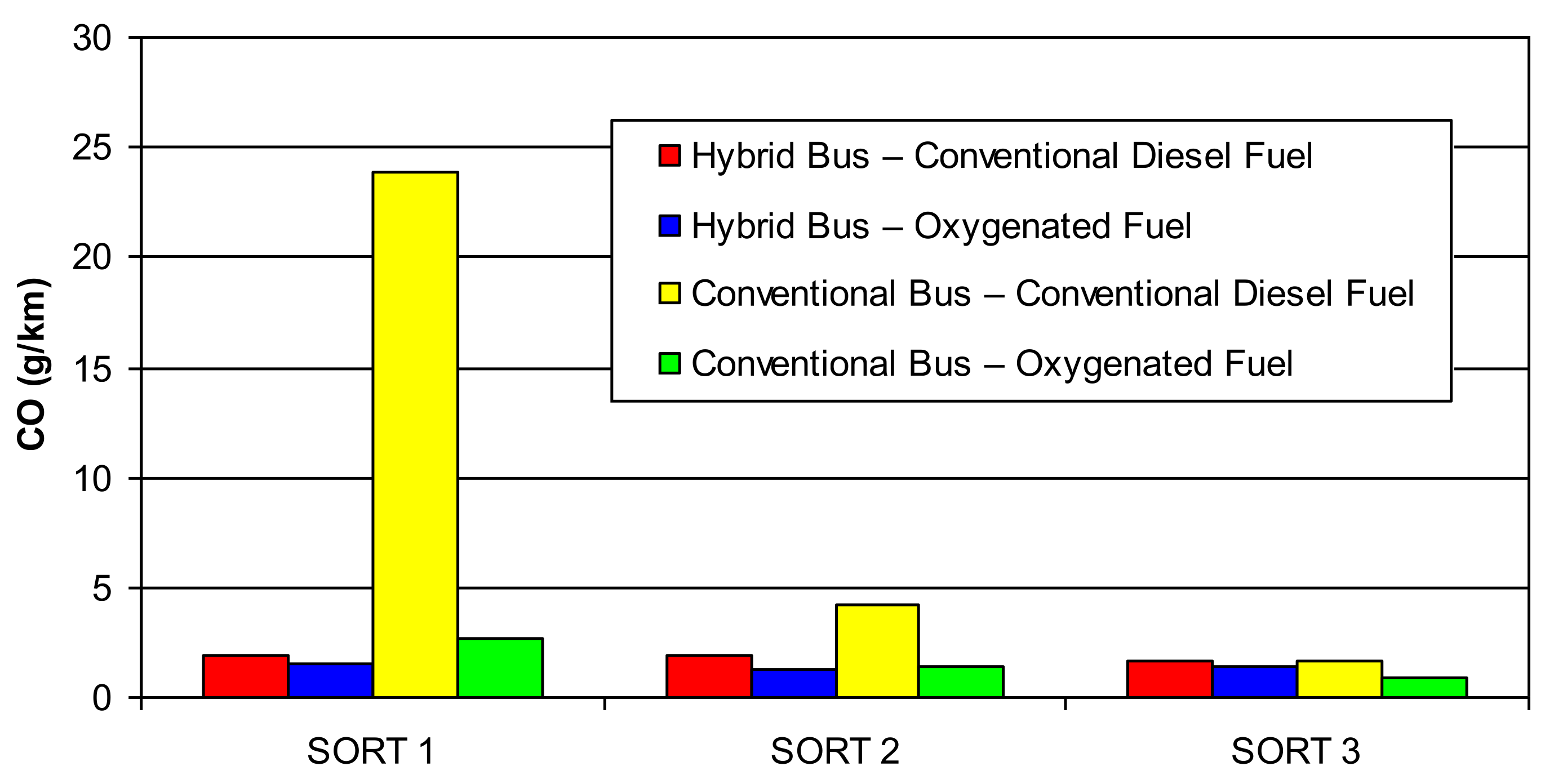
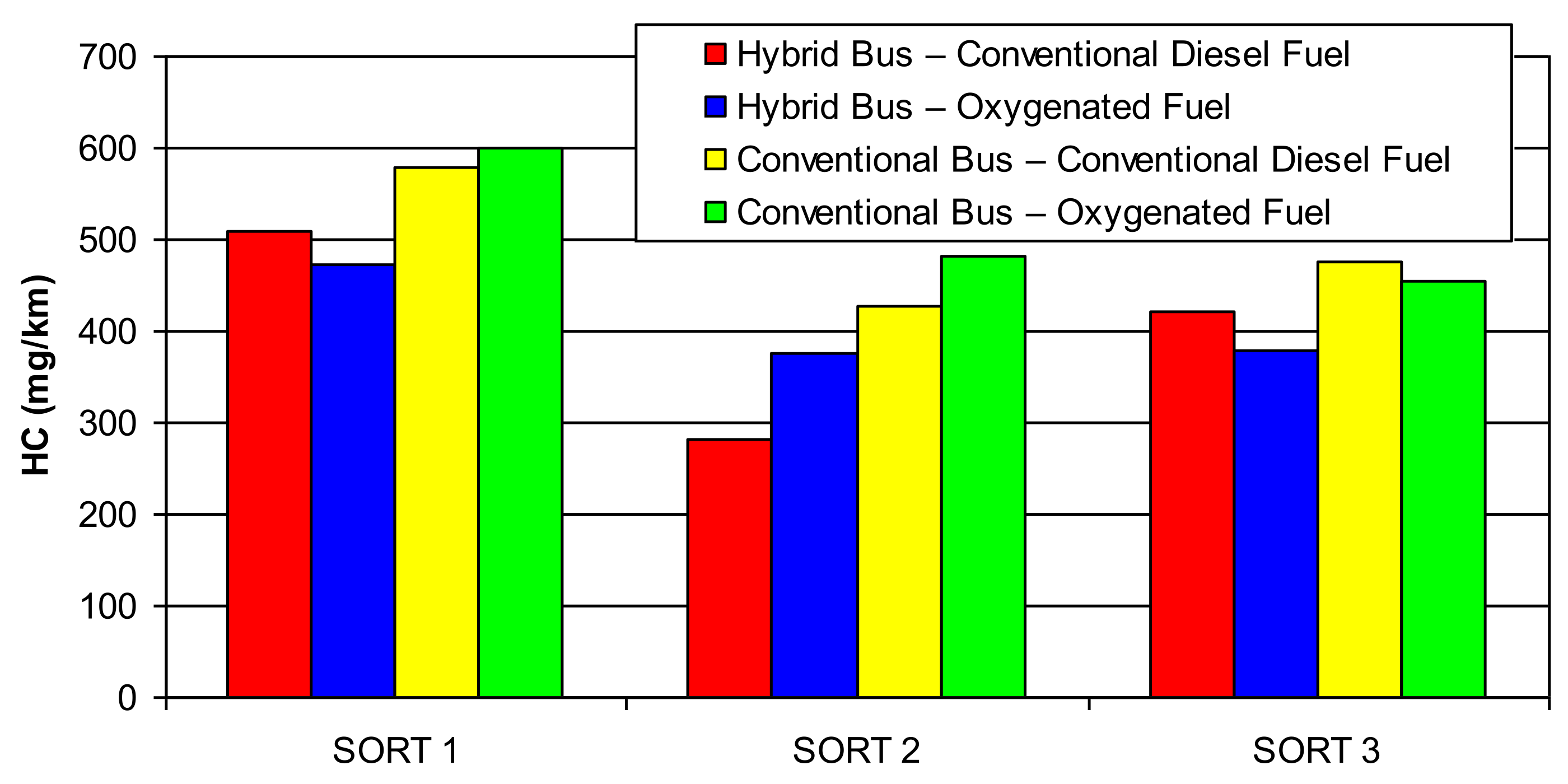
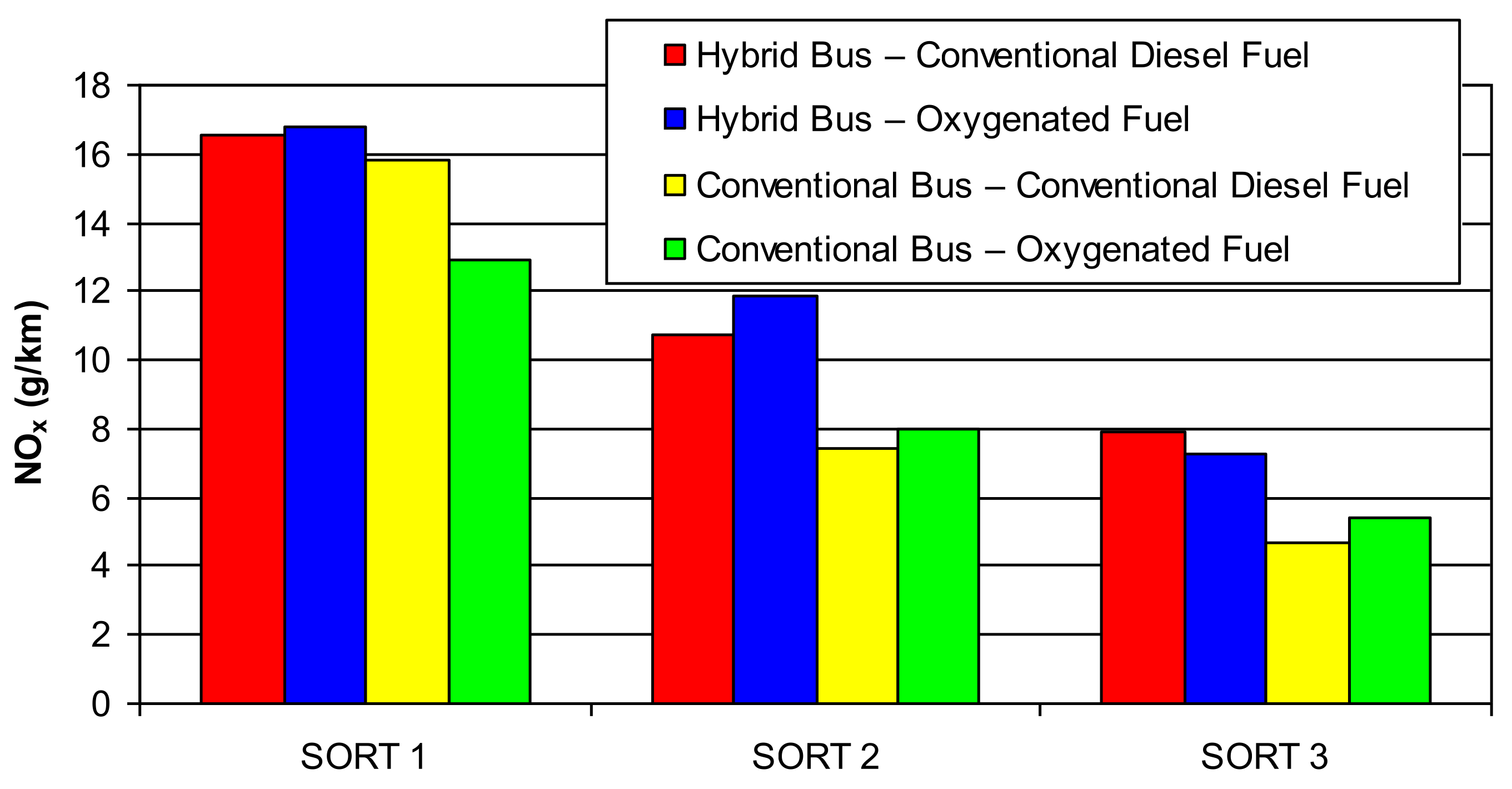
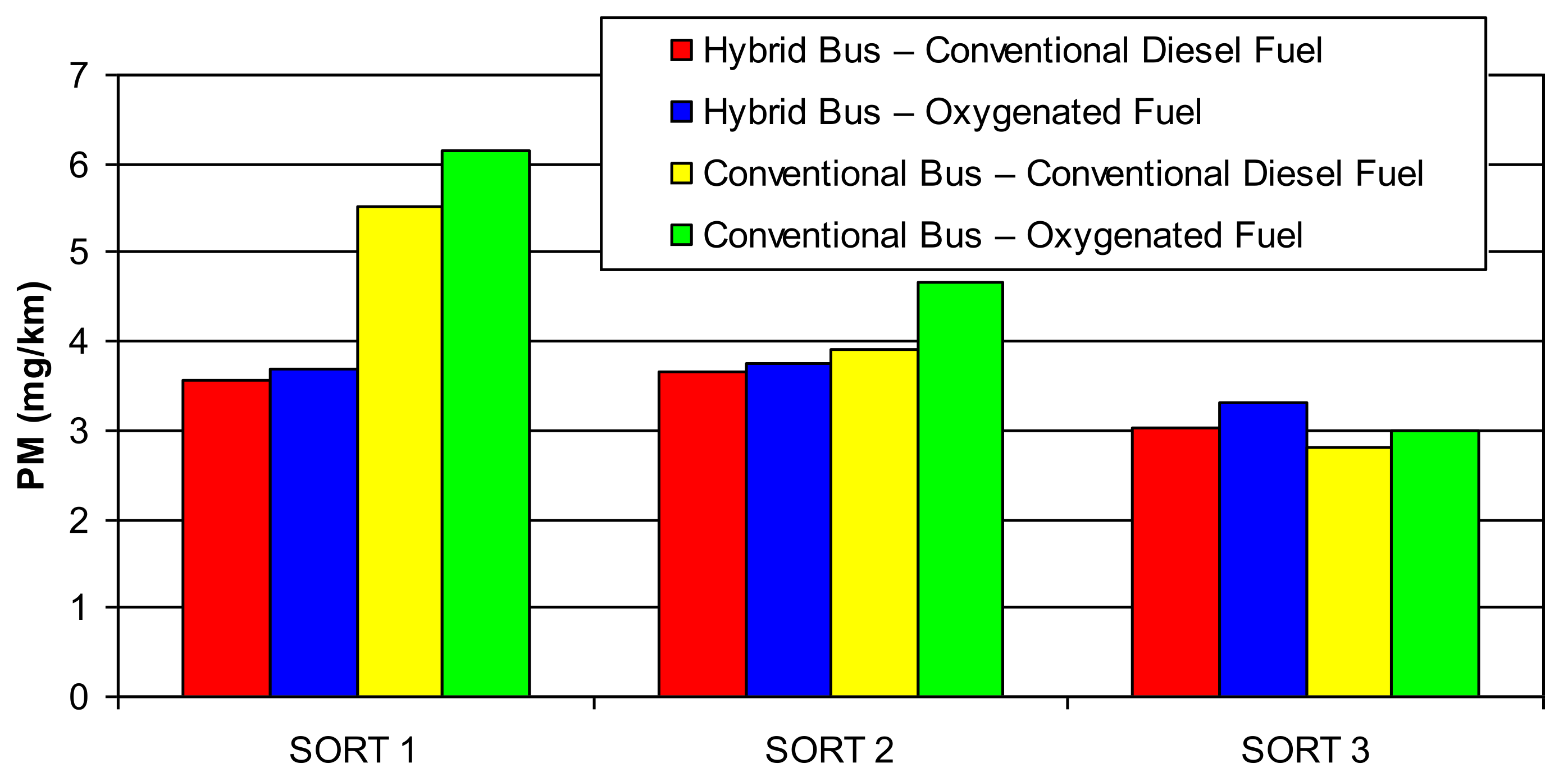
| Property | Unit | Value |
|---|---|---|
| Molecular weight | amu | 178.23 |
| Oxygen content | % (m/m) | 36.0 |
| Boiling point | °C | 220 |
| Melting point | °C | −45 |
| Density @ 20 °C | kg/m3 | 987 |
| Viscosity @ 20 °C | mm2/s | 2.5 |
| Flash point | °C | 113 |
| Cetane number (calculated) | – | 144 |
| Chemical formula |  C8H18O4 |
| Properties | Unit | Value | |
|---|---|---|---|
| Cetane number | – | 52.8 | |
| Cetane index | – | 53.4 | |
| Density @ 20 °C | kg/m3 | 827.7 | |
| Sulphur content | ppm | 8.8 | |
| Viscosity | @ 20 °C | mm2/s | 4.096 |
| @ 40 °C | mm2/s | 2.607 | |
| Distillation | E250 | % (v/v) | 38.1 |
| E350 | % (v/v) | – | |
| T95 | °C | 332.3 | |
| FBP | °C | 343.7 | |
| Aromatic Hydrocarbons | Total aromatics | % (m/m) | 20.7 |
| Monoaromatics | % (m/m) | 18.8 | |
| Diaromatics | % (m/m) | 1.7 | |
| Tri + aromatics | % (m/m) | 0.2 | |
| Total PAH | % (m/m) | 1.9 |
| Exhaust Component | Measuring Method | Accuracy |
|---|---|---|
| CO | NDIR, range: 0–10% | ±3% |
| HC | FID, range: 0–10,000 ppm | ±2.5% |
| NOx | NDUV, range: 0–3000 ppm | ±3% |
| CO2 | NDIR, range: 0–20% | ±3% |
| Parameter | Value |
|---|---|
| Measuring range | 0–50 mg/m3 |
| Resolution | 0.001 mg/m3 |
| Dilution factor | 5000 |
| Sampling of exhaust gas | 2 dm3/min |
| Analyzer operating conditions | temperature: 5–45 °C humidity: 0–95% |
| Parameter | Unit | Value |
|---|---|---|
| Total distance | km | 16 |
| Average speed | km/h | 18–22 |
| Top speed | km/h | 60 |
| Stop share | % | 20–30 |
| Number of stops | – | 46 |
| Route type (characteristics) | – | The very centre of the city and the main communication arteries |
| SORT 1 | SORT 2 | SORT 3 | |
|---|---|---|---|
| Average speed (km/h) | 12.6 | 18.6 | 26.3 |
| Stop share (%) | 39.7 | 33.4 | 20.1 |
| Number of stops per km (1/km) | 5.8 | 3.3 | 2.1 |
| Profile (trapezium) 1: constant speed (km/h)/distance (m) | 20/100 | 20/100 | 30/200 |
| Profile (trapezium) 1: acceleration (m/s2) | 1.03 | 1.03 | 0.77 |
| Profile (trapezium) 2: constant speed (km/h)/distance (m) | 20/200 | 40/220 | 50/600 |
| Profile (trapezium) 2: acceleration (m/s2) | 0.77 | 0.62 | 0.57 |
| Profile (trapezium) 3: constant speed (km/h)/distance (m) | 40/220 | 50/600 | 60/650 |
| Profile (trapezium) 3: acceleration (m/s2) | 0.62 | 0.57 | 0.46 |
| Stop time after each profile (s) | 20/20/20 | 20/20/20 | 20/10/10 |
| Total distance (m) | 520 | 920 | 1450 |
| Deceleration (m/s2) | 0.8 | 0.8 | 0.8 |
| Parameter | Value |
|---|---|
| Length | 18 m |
| Drivetrain type | Serial hybrid |
| Electric motor maximum power | 240 kW |
| Electric generator maximum power | 200 kW |
| Combustion engine type | Diesel, six-cylinder, in-line |
| Displacement | 6.7 dm3 |
| Compression ratio | 17.3 |
| Maximum power | 209 kW @ 2300 rpm |
| Maximum torque | 1008 Nm @ 1200 rpm |
| Combustion system | Direct injection, common rail injection system, turbocharging with intercooling |
| Exhaust gas recirculation | Electronically controlled, cooled |
| Exhaust aftertreatment | DOC/DPF/SCR |
| Emission standard | Euro VI |
| Parameter | Value |
|---|---|
| Length | 18 m |
| Engine type | Diesel, six-cylinder, in-line |
| Displacement | 9.2 dm3 |
| Compression ratio | 17.4 |
| Maximum power | 231 kW @ 1900 rpm |
| Maximum torque | 1275 Nm @ 1100–1710 rpm |
| Combustion system | Direct injection, common rail injection system, turbocharging with intercooling |
| Exhaust gas recirculation | Electronically controlled, cooled |
| Exhaust aftertreatment | DOC/DPF/SCR |
| Emission standard | EEV |
Publisher’s Note: MDPI stays neutral with regard to jurisdictional claims in published maps and institutional affiliations. |
© 2022 by the authors. Licensee MDPI, Basel, Switzerland. This article is an open access article distributed under the terms and conditions of the Creative Commons Attribution (CC BY) license (https://creativecommons.org/licenses/by/4.0/).
Share and Cite
Kozak, M.; Lijewski, P.; Waligórski, M. Exhaust Emissions from a Hybrid City Bus Fuelled by Conventional and Oxygenated Fuel. Energies 2022, 15, 1123. https://doi.org/10.3390/en15031123
Kozak M, Lijewski P, Waligórski M. Exhaust Emissions from a Hybrid City Bus Fuelled by Conventional and Oxygenated Fuel. Energies. 2022; 15(3):1123. https://doi.org/10.3390/en15031123
Chicago/Turabian StyleKozak, Miłosław, Piotr Lijewski, and Marek Waligórski. 2022. "Exhaust Emissions from a Hybrid City Bus Fuelled by Conventional and Oxygenated Fuel" Energies 15, no. 3: 1123. https://doi.org/10.3390/en15031123
APA StyleKozak, M., Lijewski, P., & Waligórski, M. (2022). Exhaust Emissions from a Hybrid City Bus Fuelled by Conventional and Oxygenated Fuel. Energies, 15(3), 1123. https://doi.org/10.3390/en15031123







